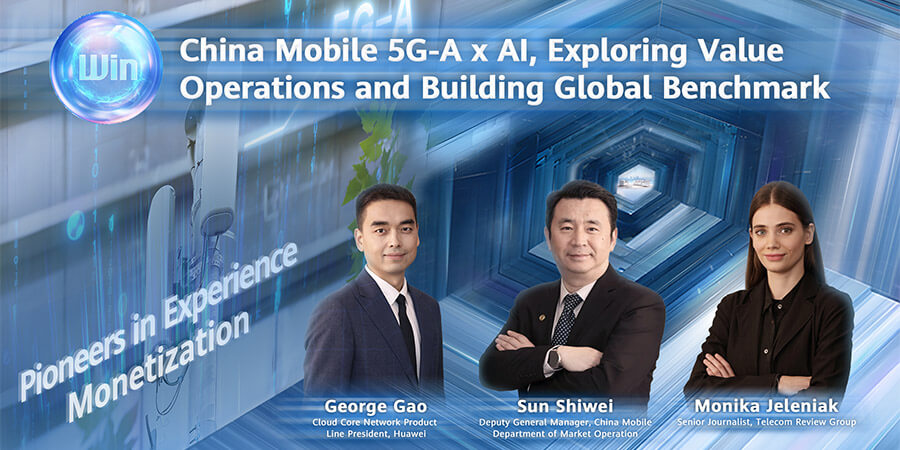In an exclusive WinWin interview hosted by Telecom Review, Sun Shiwei, Deputy General Manager of China Mobile Department of Market Operation, and George Gao, President of Huawei’s Cloud Core Network Product Line, shared their valuable insights into China Mobile’s pursuit for value-driven operations and its efforts to set a global benchmark by leveraging the power of 5G-Advanced (5G-A) and artificial intelligence (AI).
Adding a unique dimension to the conversation, WinWin, an AI agent, offered fresh perspectives on how the convergence of 5G-A and AI creates new opportunities for telecom operators and industries worldwide.
China Mobile’s 5G-A Deployment and Value Operations
Sun began by emphasizing the importance of network abilities as the foundation for operators. However, he pointed out that a noticeable shift from traditional traffic-based monetization to a focus on user experiences (UX) has emerged. “User experiences are becoming the key driver for network innovation and are now the center of customer service improvement,” he explained.
He elaborated on the launch of China Mobile’s 5G-A network, noting that in March 2024, the world’s first 5G-A network was rolled out in Zhejiang, Hangzhou. This marked the start of commercial 5G-A deployment across over 300 cities in China. “Currently, 64 types of terminals are supported by 5G-A networks,” Sun shared, underscoring the scale of China Mobile’s deployment.
In addition, China Mobile launched 5G-A experience packages based on rates in seven provinces, including Shanghai and Zhejiang. These packages aim to enhance user experiences by offering dedicated 5G-A network logos and New Calling services.
“Through all these measures, we can provide intelligent and different experiences, ensure operations of key services, improve our brand image, sustain user growth, and also improve the overall value,” explained Sun.
Huawei’s Role in Enabling Experience Monetization
Gao then spoke about Huawei’s contributions to helping operators monetize value through AI- and experience-driven models. He discussed Huawei’s launch of the Personalized Experience Agent, which introduces intelligence to network connections, enables differentiated experiences, and paves the way for experience monetization.
“We launched the IPE, or Intelligent Personalized Experience solution, to safeguard user experience. By leveraging large models for service QoE (quality of experience) training and inference, we achieve end-to-end, real-time user experience assurance,” explained Gao.
One of the standout features of Huawei’s solution is MyLogo, which displays specified logos on terminals in subscribed locations or scenarios. These logos enable users to recognize their service status immediately and access the necessary acceleration packages. Gao emphasized that this serves as an entry point for experience monetization, as it makes user experiences more visible and tangible, while ensuring services are easily accessible.
China Mobile’s AI-Driven Innovation
Elaborating on service innovation and development, Sun detailed how the company integrates AI into its products and services. With the broad deployment of 5G-A and the rapid adoption of AI, China Mobile has been actively pursuing its ‘AI+’ strategy. This product model combines AI with platforms, networks, and applications. “We’ve launched more than 20 ‘AI+’ products,” Sun revealed. These include services like New Calling, cloud phones, and glasses-free 3D devices. With over 40 million active users for New Calling and over 20 million using cloud phones, China Mobile is leveraging AI to create personalized, innovative customer experiences (CX).
Additionally, Sun spoke about the services China Mobile has developed to lay the foundation for the AI era, including artificial intelligence-generated content (AIGC) digital humans and AI home hubs. These services offer tailored experiences that will drive China Mobile’s continued innovation and market expansion.
Huawei’s Vision for AI-Integrated Core Networks
Gao then discussed Huawei’s approach to core network transformation, particularly in the context of AI integration. He noted that integrating AI into the core network is inevitable in the mobile AI era. To facilitate this, Huawei launched the AI Core Network at Mobile World Congress (MWC) Barcelona 2025. This represents a shift from merely embedding AI into the network to using AI-native technologies to reconstruct the core network.
“The evolution unfolds in two phases,” Gao explained. “In the first phase, the 5G-A intelligent core network incorporates AI agents to achieve service, network, and operation and maintenance (O&M) intelligence, providing three intelligent entries. In the second phase, we’ll build an agentic core network based on AI-native technology.” This network will feature a series of network agents, creating an autonomous, self-optimizing network that can perform self-operation and maintenance.
Gao explained that the ultimate goal is to develop a telco AI system capable of meeting the real-time, personalized requirements of services and accelerating the adoption of inclusive AI across industries. The AI core network also integrates computing and networking capabilities, extending intelligent network functions to user devices and vertical industries. This approach shifts the focus from mere connectivity to intelligent connectivity driven by AI agents. By doing so, Huawei helps operators accelerate network business monetization, empowering vertical industries and fostering a future-oriented ecosystem.
Sun and Gao aptly emphasized the transformative potential of converging 5G-A with AI to enhance user experience, drive innovation, and facilitate new avenues for monetization in the telecommunications industry.
Their insights underscored the importance of AI-driven solutions in shaping the future of global connectivity and network operations.
